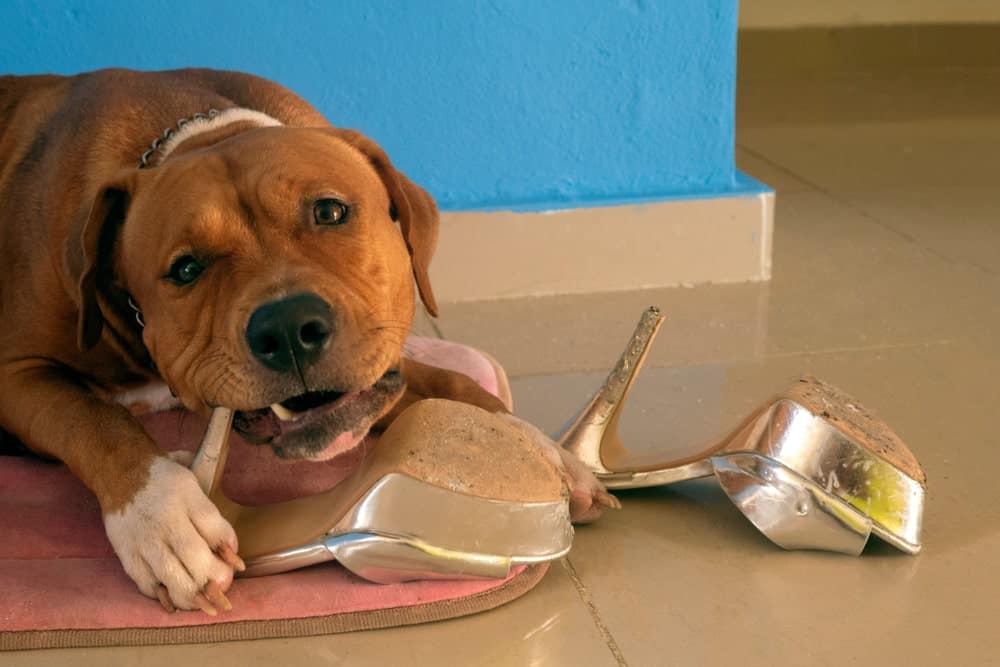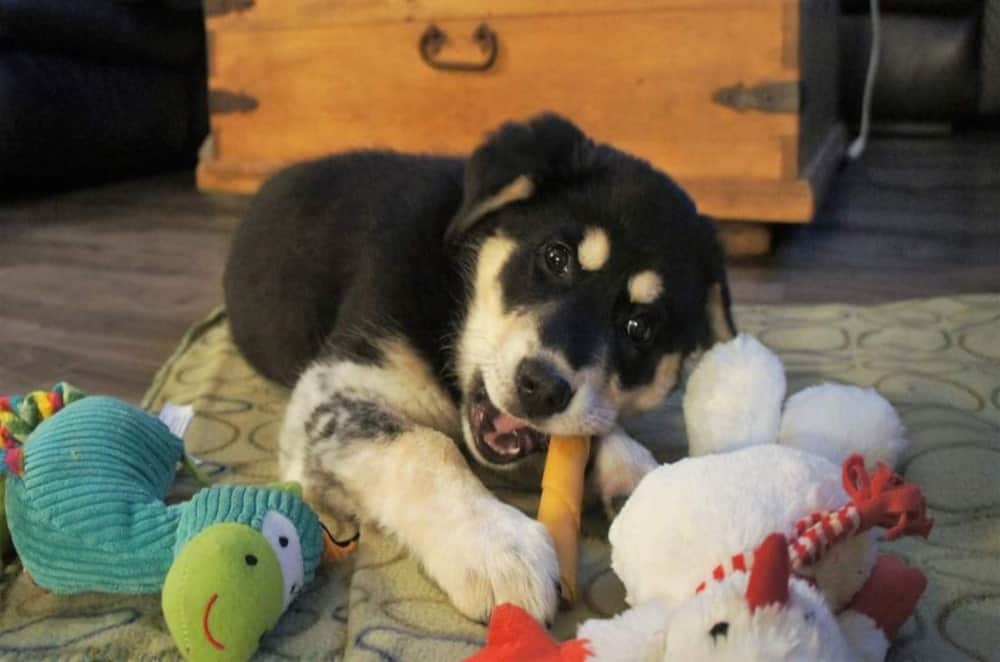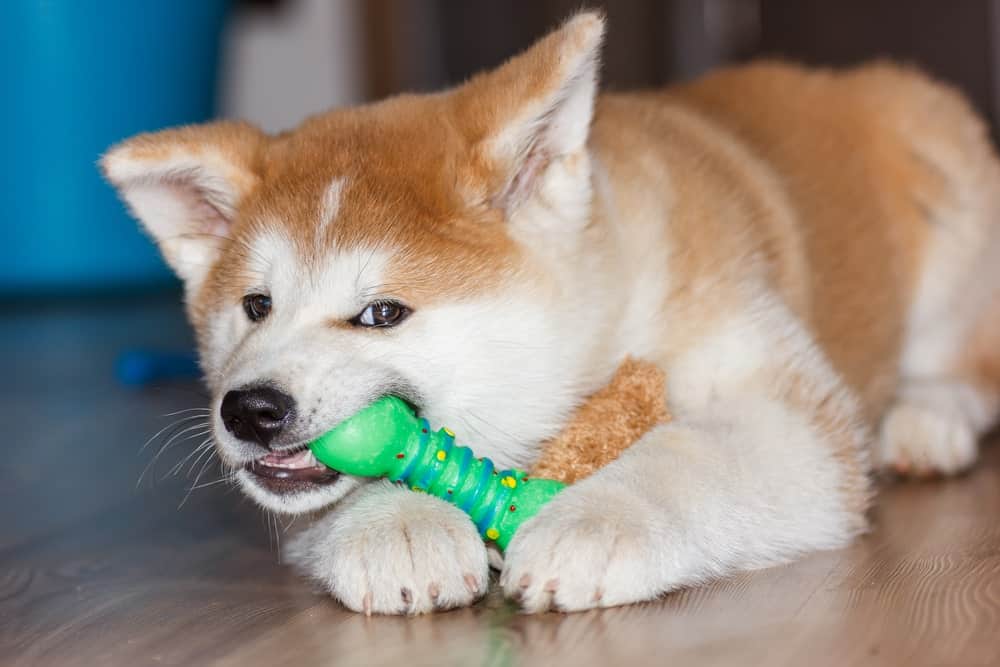“This post contains affiliate links, and I will be compensated if you make a purchase after clicking on my links.”
Does your dog have a tendency to wrap his teeth around everything in sight? One sure sign of a new dog or puppy owner is chewed up edges on furniture and baseboards, frayed carpeting, destroyed shoes, or gutted pillows and dog beds. So how can you stop your dog from chewing everything in sight? Lots of attention, mostly! Read on.

Significant chewing is fairly normal for puppies, especially when they are less than one year old and during heavy teething stages. At around four months of age, young dogs can start learning how not to chew on anything they can fit their teeth around and instead be taught what items are appropriate for chewing. This is an essential behavior to teach, not only for preventing the total destruction of your home and belongings, but for protecting a dog who might accidentally chew on something dangerous or toxic, choke on or ingest an inedible object.
Common Causes of Excessive Chewing
The most common cause of excessive chewing in young dogs and puppies is teething. Just like human babies, dogs’ gums can become sore during this stage of growth. Because they’re feeling soreness and discomfort, puppies resort to chewing whatever they can get their teeth on in an attempt to get some relief. Because chewing offers some comfort and relief, the act itself is rewarding to the dog. As a result, over time, chewing can become a learned rewarding behavior rather than simply a means of feeling better.
Destructive chewing in dogs that are no longer teething can be a result of that learned rewarding behavior, separation anxiety, boredom, or inadequate exercise. In order to put an end to destructive chewing, pet parents will need to first determine the reason it’s happening.
Help for Teething Puppies
If your dog’s excessive chewing is a result of teething, there are several ways to soothe his sore mouth and gums while at the same time teaching him which items are appropriate to chew. Specially designed teething toys for dogs are made in a variety of textures, shapes, and sizes perfect for your growing dog’s needs. They are often rubbery or made with rope that is perfect for gnawing, they may have knobby textures that serve to massage sore gums, or may be meant to freeze before giving to the dog for the added benefits of applying a cold compress to ease pain.

Other Reasons Dogs Chew
Many dogs chew as a way to release pent up energy, to quell boredom, or due to separation anxiety. While chewing due to separation anxiety may require the help of a trainer or animal behaviorist, providing adequate mental and physical stimulation and exercise is the number one most effective way to slow destructive chewing.
Veterinarians recommend a minimum of 20 minutes of aerobic exercise every single day. But, many dogs – especially puppies and young adults – will benefit from much more than that. In addition to physical exercise that gets your dog’s heart rate up, mental exercise and brain games are an excellent way to release extra energy. It has been said that 10 minutes of mental stimulation – in the form of training exercises, dog puzzles, games, and problem solving – is as physically exhausting as twice that time spent doing physical exercise.
Correcting the Behavior
The key to keeping your dog from chewing everything in sight is to both provide fairly constant supervision and to offer appropriate alternatives when the chewing behavior begins. Until your dog learns which items are safe for chewing, like toys, chewy treats, and dog-safe bones, you’ll need to constantly and consistently monitor his behavior.
At the exact moment your dog begins to chew something inappropriate, say “No” or “Leave it” in a calm but firm voice. Take the inappropriate item away – or, in the case of furniture, redirect your dog away from it – and immediately offer him an appropriate object for chewing. The moment he begins chewing the appropriate item, reward him either with praise and petting, or offer a small, tasty training treat. Although being able to chew something is rewarding in itself, offer additional reward will further reinforce correct chewing behavior and will help him to learn which items earn extra rewards.
Although some pet parents swear by the use of “penny cans” or spraying water at their dog when they’re chewing inappropriately, this method of correction serves to frighten or startle a pup, thus causing them to avoid repeating the behavior, but does nothing to teach them what is appropriate. There are much better ways to correct your dog than to strike fear in him. Also remember, it’s best to avoid the use of harsh corrections such as screaming, smacking, or hitting your dog as the stress it causes can often result in more destructive chewing behavior.
Other Tips & Tricks
If, despite your best efforts, your dog is still attracted to chewing on certain items in your home, like chair legs, the corner of a sofa, or a potted plant, a spritz of Bitter Apple Spray on the forbidden object is perfectly safe but tastes awful to a dog. Very often, just one mouthful of the awful taste is enough to make a dog never again wrap his lips around that object.
Because it can take several months for excessive and problematic chewing behavior to be completely eliminated, it is highly recommended that owners provide a safe place for their dogs to go when they aren’t under close supervision. A crate is perfect for keeping your dog (and your belongings!) safe when he’s home alone. If a crate isn’t a suitable option for you, make sure that dangerous items such as electrical cords are not left on the floor, toxic plants are removed, and other poisonous objects or liquids are kept out of reach.
Use caution, though. If your dog is an excessive chewer, locking him up in a room might result in him chewing his way out! (I’ve seen a dog eat half of a door to escape a room!)
Truthfully, chewing and gnawing is fun for a lot dogs. If your four-legged friend simply loves to chew, make sure to provide him with many safe objects, in a variety of textures and sizes. Look for long-lasting chewy treats, like bully sticks, dog-safe bones, or a Kong toy filled with peanut butter.

What Not to Do
Because dogs don’t generalize well, you may find that you’ve successfully taught him not to chew on one chair leg, while he simply moves to the next. Remember, this process takes time and effort. You may need to repeat the process multiple times until he finally understands which items are appropriate. Also, do not give your dog any items of yours that are similar to items he should not chew such as old shoes, clothes, or pillows that you no longer want. While you may not care that he destroys these items, he won’t understand that “these” shoes are ok to chew but “those” shoes are not.
Rawhide treats are a popular choice for the parents of dogs that love to chew, but always use extreme caution when giving a dog rawhide. Because they are not easily digestible but are able to be ripped and torn, many, many dogs end up in emergency surgery following an intestinal blockage after swallowing a bit of the chewy snack. Rawhides can also very easily become a choking hazard. Never, ever leave a dog unattended while he’s chewing a rawhide.
In some rare cases, an older dog may begin chewing excessively as a result of an underlying health problem. If your dog suddenly develops a chewing habit, but you know he isn’t teething, does not suffer from separation anxiety, and isn’t bored or under-exercised, a trip to the veterinarian may be in order.
Do you have any other tips for teaching a dog to stop chewing? Share them in a comment below!



















Rick Sander
Jul 17, 2021 at 4:56 am
There may be times when you’re panicked over what your dog is chewing—such as a bottle of medication—which is why training them to trade you for treats will ensure they give up even the most fun items. Scolding or pulling things out of your dog’s mouth can cause behavior issues to develop. Why risk your dog’s trust when positive reinforcement methods are more effective? And that “guilty look” is actually a canine submissive posture that dogs show when they feel threatened or unsafe. When you’re angry and upset, your dog feels threatened by your tone of voice, body language and/or facial expressions, so they may hide or show submissive postures. Building and maintaining a positive, trusting relationship with your dog is the foundation of a happy life together!